
foreword | Historical Narratives | Resources | Links | Contact
REMEMBER BROCK, PART 1
"History is someone's memories of momentous events."
Individuals are made great by the causes they serve. Brock saved Upper Canada.
His subsequent death in the thick of battle made him immortal.
 |
|
Sir Isaac Brock |
Brock, our chief of men, who through a cloud
Not of war only, but detractions rude,
Guided by faith and matchless fortitude,
To peace and truth thy glorious way has ploughed.
In reporting on Brock's death at Queenston, the York Gazette urged the public to "Remember Brock" for his steadfast, stirring leadership. There was little need to be remind residents to remember him, for the grateful public remembered Brock many times and in many ways, both here and in his homeland, as the man who saved of Upper Canada.
The search for national heroes does not generally fall far from fighting. They flame forth in the torches of a nation saved in war. More than any other individual during the War of 1812, Isaac Brock foiled American prospects of an easy conquest of Canada. In doing so, he kept the country independent. Resourceful, daring, courageous - Brock became the idol of the hour in Canada and in Britain. When news of his Detroit victory reached London on October 6th, church bells pealed, feu de joie filled the air and bonfires blazed throughout the night. By a peculiar paradox history not infrequently produces, the very day of their rejoicing was forty-third birthday of Isaac Brock. The Times said: "General Brock fell like Leonidas and doubtless like the Greek hero's name, Brock's will live forever in the grateful memory of his country." Brock prevailed against the American invaders because of his great personal daring and his ability to draw forth from the regulars, the militia and his Native allies, their best efforts.
The Prince Regent, who was ruling in the absence of crazed King George III, hailed the news of Brock's easy conquest at Detroit. Because of the overwhelming difficulties Brock had faced and the singular judgement, skill and courage with which he surmounted them, the Prince promptly appointed him an extra knight of the most honourable Order of the Bath. [*] The honours were gazetted on October 10, 1812. Sadly, 'Sir Isaac,' who had so wanted to earn such an honour with Wellington's warriors in Europe, but despaired of ever doing so in the backwoods of Canada, never learned of the laurels, for by the time word of the award reached Upper Canada, Brock was dead.
In a dispatch to Sir George Prevost from Earl Bathurst, Secretary of State for the Colonies, the following tribute was paid by the British Government to the memory of General Brock.
"His Royal Highness the Prince Regent is fully aware of the severe loss which His Majesty's service has experienced in the death of Major-General Sir Isaac Brock, that would have been sufficient to have clouded a victory of much greater importance. His Majesty has lost in him not only an able and meritorious officer, but one who in the exercise of his functions of Provincial Lieutenant-Governor of the Province, displayed qualities admirably adapted to dismay the disloyal, to reconcile the wavering, and to animate the great mass of the inhabitants against successive attempts of the enemy to invade the Province, in the last of which he fell too prodigal of that life of which his eminent services had taught us to understand the value."The gratitude of Great Britain did not end there. A public monument was decreed by the government in memory of the man who had "died to preserve what Wolfe died to gain." Approved by the Imperial Parliament on the 20th of July 1813, it was erected at a cost of 1,575 pounds sterling (approximately $80,000) in St. Paul's Cathedral, the last resting place also of Britain's two other great warriors, Nelson and Wellington. Located on the main floor in the western ambulatory of the south transept, the memorial was executed by Sir Richard Westmacott, a renowned British sculptor. It is a military monument with Brock's corpse reclining in the arms of a British soldier, whilst nearby a Native warrior pays regretful tribute to his bravery and humanity. At the top of memorial are sculpted the sword and helmet of the deceased, both paid for by his companions in gratitude and devotion to their lamented commander.
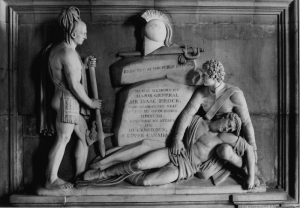 |
|
Monument to Sir Isaac Brock in St. Paul's Cathedral |
Erected at the Public Expense
To the Memory of
MAJOR GENERAL SIR ISAAC BROCK,
Who gloriously fell on the 13th of October
M.D.C.C.C.XII,
In resisting an attack on Queenston,
In Upper Canada.
In Guernsey, an island in the English Channel just off the coast of France, the people celebrated their famous native son, Isaac Brock, in a number of ways. He was the subject of their very first special issue commemorative stamp. Brock's childhood home on High Street, St Peter Port Guernsey still stands and is marked with a memorial plaque. Brock University provides scholarships to Guernsey students who achieve sufficiently high grades.
"Major-General Sir Isaac Brock, the Guernseyman who became President and Administrator of Upper Canada, and was killed defending Queenston Heights."
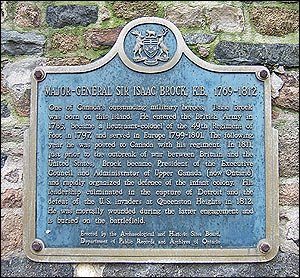 |
|
Brock Memorial Plaque |
Major-General Sir Isaac Brock KB 1769-1812
One of Canada's outstanding military heroes, Isaac Brock was born on this island. He entered the British army in 1765, became a lieutenant-colonel of the 49th Regiment of Foot in 1797 and served in Europe 1799-1801. The following year he was posted to Canada with his regiment. In 1811 just prior to the outbreak of war between Britain and the United States, Brock became President of the Executive Council and Administrator of Upper Canada (now Ontario), and rapidly organized the defence of the infant colony. His leadership culminated in the capture of Detroit and the defeat of the United States invaders at Queenston Heights. In 1812, he was mortally wounded during the latter engagement and is buried on the battlefield.
Erected by the Archeological and Historic Sites Board
Department of Public Record and Archives of Ontario
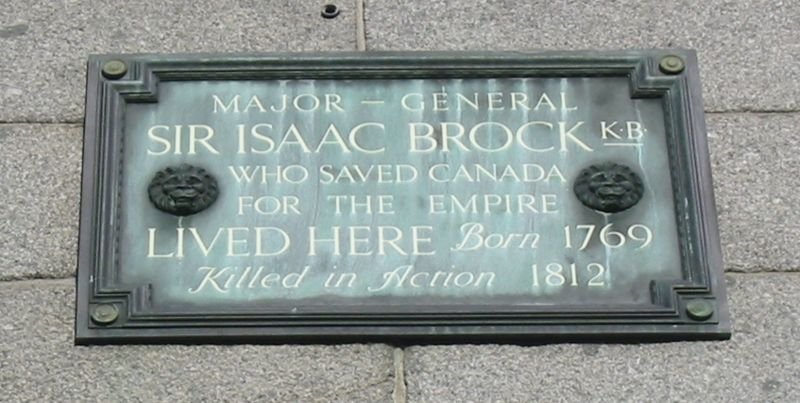 |
|
Brock Plaque in Guernsey |
Inscribed on an oak screen in the parish church of St. Peter Port, the island's capital, are the words:
Sir Isaac Brock, K.B.
Who Saved Canada
Down a narrow, crooked, cobblestone street in the centre of town, on the side of the gray, granite building where Brock was born, a simple plaque says it all.
He saved Canada.
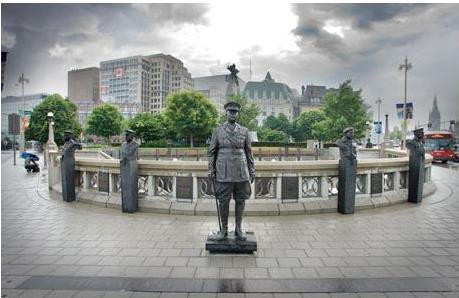 |
|
Valiants' Memorial, Ottawa |
"On November 05, 2006, Governor General, Michaelle Jean, the Honourable Gregory Thompson (Minister of Veterans Affairs), the Honourable Gordon O’Connor (Minister of National Defence), unveiled the new Valiants Memorial, in Ottawa, on the northeast side of the National War Memorial. The new Memorial is a collection of nine busts and five statues depicting individuals from critical periods of conflict in our nation’s history, as well as a large bronze wall. The men and women honoured in the Memorial were selected on the advice of the Valiants Foundation, composed of distinguished military historians. The Memorial honours these fourteen valiant men and women for their heroism during five periods of conflict and resolution which marked Canada’s road from a seventeenth century European colony to a twentieth century North American nation. The inscription on the wall reads:
Nulla dies umquam memori vos eximet aevo,
No day shall ever erase you from the memory of time.
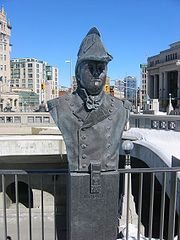 |
|
Brock A Valiant |
In 1969 Canada commemorated the 200th anniversary of Brock's birth with a six cent stamp featuring Brock and his monument.
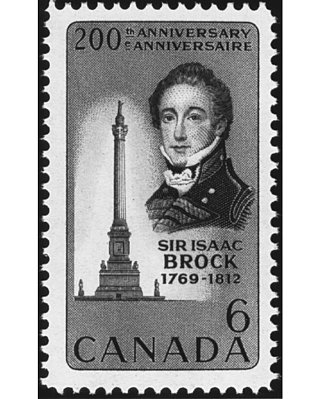 |
|
Canadian Commemorateive Stamp to Sir Isaac Brock and His Monument |
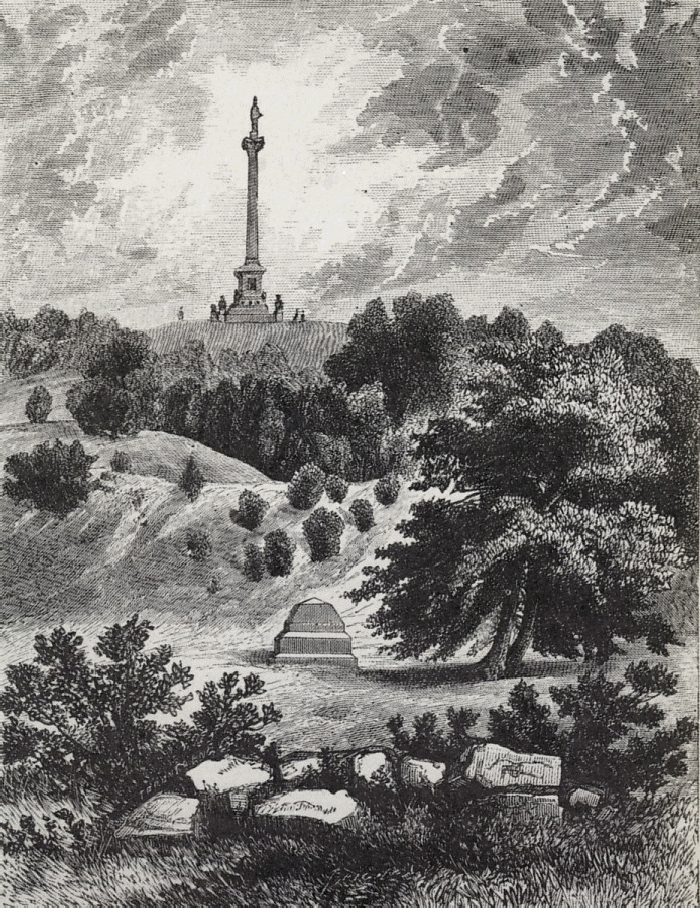 |
|
The concrete monument marking the spot where Brock died, looks towards the tower that glorifies his memory forever in the hearts of Canadians. |
[*] The Order of the Bath is the largest order of Knighthood and the highest honour to which Commoners can hope to attain. The name results originally from an initiatory ceremony that involved bathing.
Copyright © 2013 Website Administrator